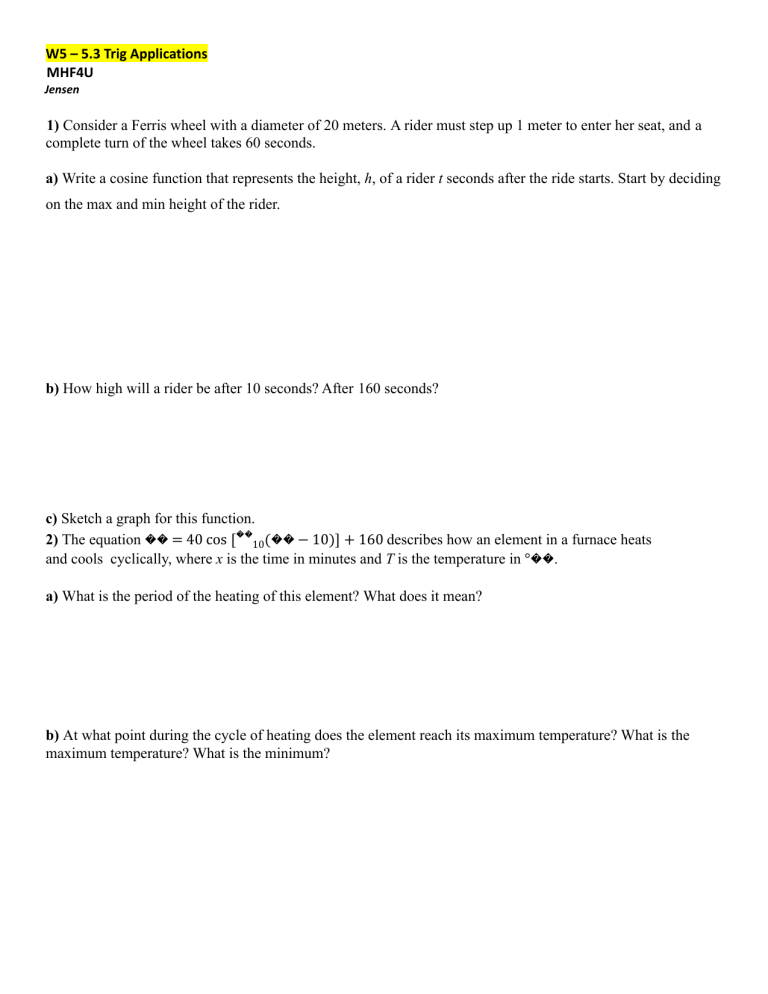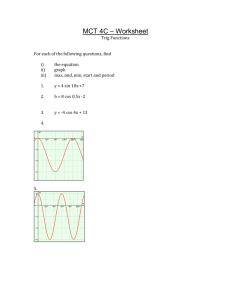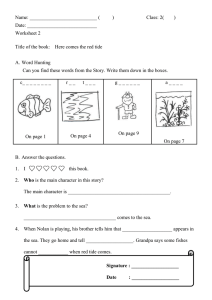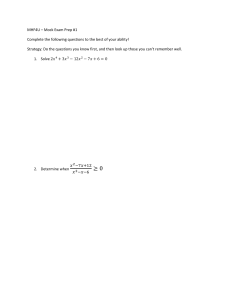
W5 – 5.3 Trig Applications MHF4U Jensen 1) Consider a Ferris wheel with a diameter of 20 meters. A rider must step up 1 meter to enter her seat, and a complete turn of the wheel takes 60 seconds. a) Write a cosine function that represents the height, h, of a rider t seconds after the ride starts. Start by deciding on the max and min height of the rider. b) How high will a rider be after 10 seconds? After 160 seconds? c) Sketch a graph for this function. 2) The equation �� = 40 cos [��10(�� − 10)] + 160 describes how an element in a furnace heats and cools cyclically, where x is the time in minutes and T is the temperature in °��. a) What is the period of the heating of this element? What does it mean? b) At what point during the cycle of heating does the element reach its maximum temperature? What is the maximum temperature? What is the minimum? c) Use this equation to calculate the temperature of the element 4 minutes and 12 minutes into the cycle. d) Sketch a graph for this function. 3) During a 12-hour period, the tides in one area of the Bay of Fundy cause the water level to rise to 6 m above average sea level and to fall 6 m below average sea level. The depth of the water at low tide is 2 m. a) What is the depth of the water at average sea level? b) What is the depth of the water at high tide? c) When do high tide and low tide occur if the water is at average sea level at midnight and the tide is coming in? d) Create a sine equation to represent the scenario. Let y represent depth of the water in meters and let x represent hours after midnight. 4) A robotic arm drives in 10 spikes per minute on an assembly line. It rises to a height of 28 cm, drops to a height of 4 cm as it strikes the spike, and repeats. The arm rests (or starts) at the maximum height. a) What is the period of the motion of the robotic arm? In other words, how long does it take to go from maximum height, down to the spike and back up again to the maximum height if it does this 10 times in one minute? b) Write a cosine function that represents the height, h, of the robotic arm t seconds after the process starts. c) What will be the height of the arm after 10 seconds? After 50 seconds? d) Sketch a graph for this function. 5) A rung on a hamster wheel, with a radius of 25 cm, is travelling at a constant speed. It makes one complete revolution in 3 seconds. The axle of the hamster wheel is 27 cm above the ground. a) Sketch a graph of the height of the rung above the ground during two complete revolutions, beginning when the rung is closest to the ground. b) Describe the transformations necessary to transform �� = cos �� into the function you graphed in part a) c) Write the equation that models this situation 6) Each person’s blood pressure is different, but there is a range of blood pressure values that is considered healthy. The function ��(��) = −20 cos (5��3��) + 100 models the blood pressure, ��, in millimetres of mercury, at time ��, in seconds, of a person at rest. a) What is the period of the function? What does the period represent for an individual? b) How many times does this person’s heart beat each minute? c) Sketch a graph of the function Answer Key 1)a) �� = 10 cos [��30(�� − 30)] + 11 b) 6m @ 10s, 16m @160s ξ c) 567891 01 11 21 31 41 51 61 71 81 92 02 12 22 32 4 1234 −1 −4−3−2 ψ 1 0 2 0 3 0 4 0 5 0 6 0 7 0 8 0 9 0 100 110 120 2)a) 20 minutes. Every 20 minutes the furnace completes a cycle of heating and cooling b) Max= 40 +160 = 200, min= 160-40 = 120 When T=200, x= 10min c) 147.6 degree C @ 4 min, 192.4 degrees C @ 12 min d) ψ 200 180 160 140 120 2 04 06 08 0 100 10203040 ξ −20 3)a) 8m b) 14m c) high tide @ 3:00 am and pm, low tide @ 9:00am and pm d) �� = 6 sin (��6��) + 8 4)a) 60/10 = 6 seconds per cycle b) �� = 12 cos (��3��) + 16 c) 10cm @ 10s, 10cm @ 50s d) 1 01 21 41 61 82 02 22 42 62 8 8 6 4 2 ψ −4 −2 2 4 6 8 1 0 1 2 1 4 ξ −2 −4 5)a) b) Vertical stretch by a factor of 25, reflection in the ��-axis, vertical translation 27 units up, horizontal compression by a factor of 32�� c) �� = −25 cos (2��3��) + 27 6)a) The period of the function is 65= 1.2 seconds. This represents the time between beats of a person’s heart. b) 50 c)






